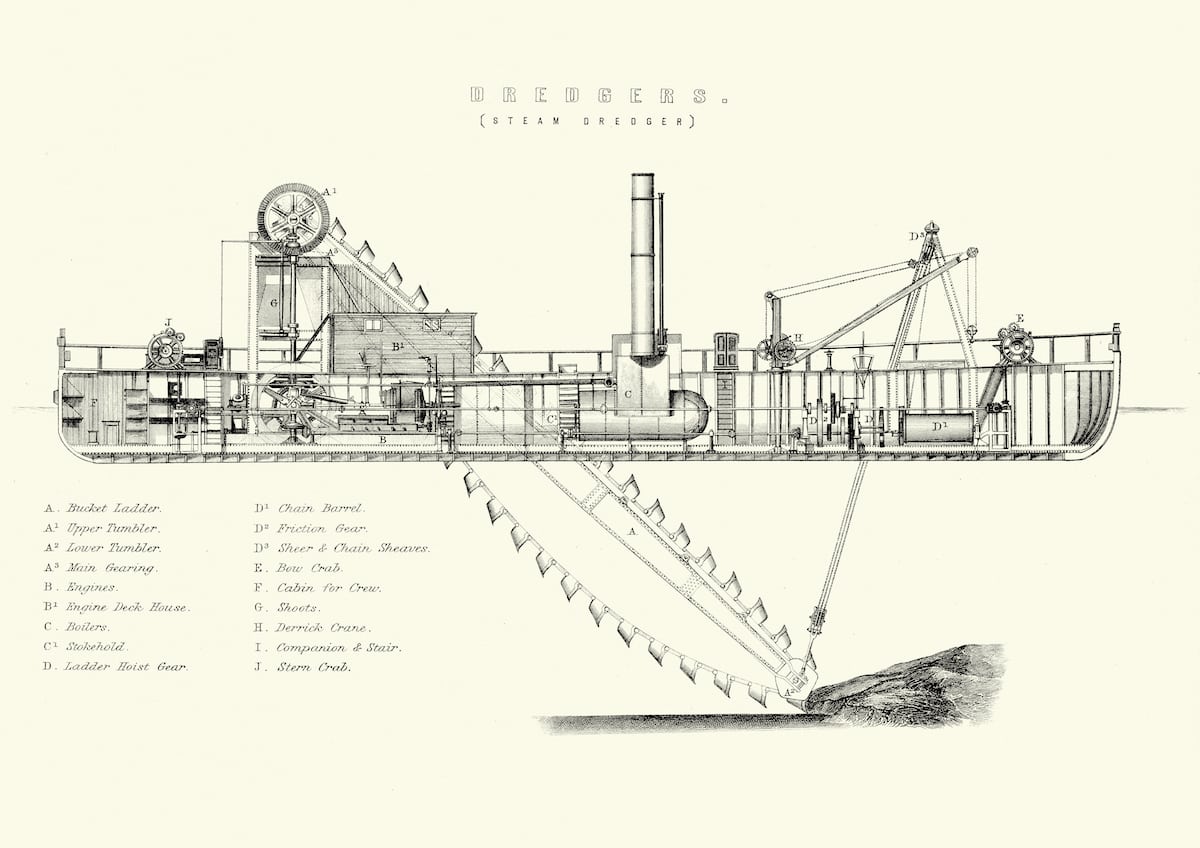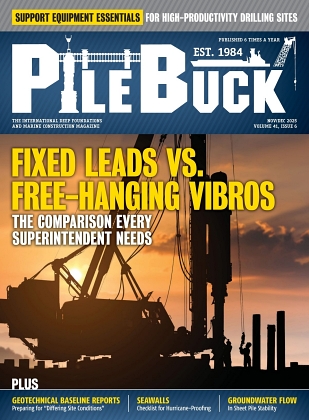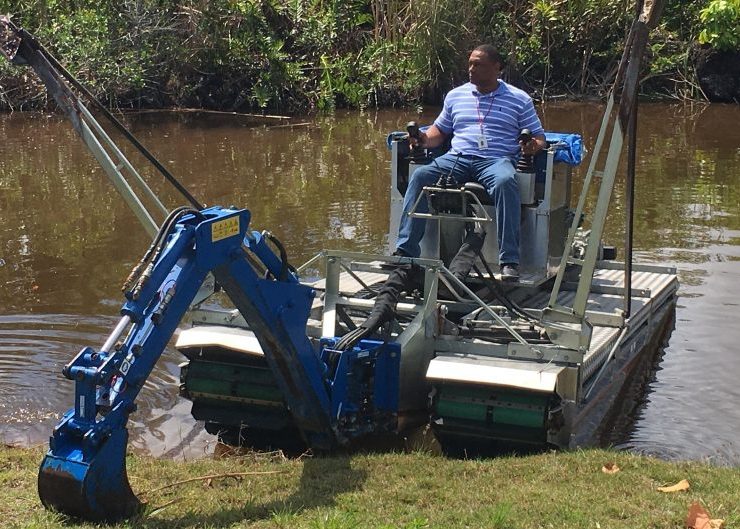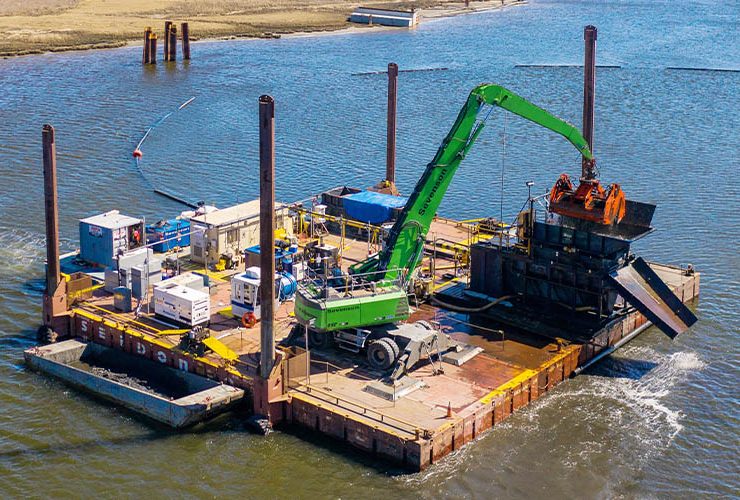Dredging Equipment Guide


View the complete article here.
The process of removing loose to compacted sediments and debris from the bottom of lakes, rivers, and harbors is paramount to the maintenance and expansion of navigation channels. The dredging of various bodies of water can also be utilized to reduce fish, wildlife, and people’s exposure to in-water contaminants.
What follows is an in-depth discussion of the equipment used for dredging projects throughout the U.S. – with a focus on application and operation – along with the advantages and limitations of each dredge type.
When selecting dredging equipment for a project, any marine contractor, government agency, or port district must initially determine:
- The physical characteristics of material to be dredged.
- The quantities of material to be dredged.
- The dredging depth.
- The distance to a disposal area.
- The physical environments of the dredging and disposal areas, along with the environments of the areas in between.
- The contamination level of sediments.
- The disposal method to be utilized.
- The overall production

Hopper Dredges
Self-propelled seagoing ships ranging in length from 180 feet to 550 feet, hopper dredges feature molded hulls and the lines of typical ocean vessels, along with sizable sediment containers, large centrifugal dredge pumps, and other specialty equipment. Fitted with twin propellers and twin rudders, this ship is adequate for free-running speed and dredging against strong currents.
Known for its excellent maneuverability in rough open seas, these dredges are classified according to their hopper capacity:
- Large Class – Capacities of 6,000 cubic yards or more
- Medium Class – Capacities of 2,000 to 6,000 cubic yards
- Small Class – Capacities of 500 to 2,000 cubic yards
Hopper dredges are primarily used for maintenance dredging in exposed harbors and shipping channels, namely where traffic and operating conditions negate the use of stationary dredges. Hopper dredges are most effective when excavating loose, unconsolidated materials that form shoals following the completion of initial dredging.
Operation
During operations, hopper dredges travel at a ground speed of 2 to 3 mph and can dredge in depths ranging from 10 feet to more than 80 feet, with dredging achieved via progressive traverses over an area.
The dredge’s suction pipes, dubbed dragarms, are moved along the channel bottom as the vessel moves. Dredged material is sucked up the pipe and deposited in the vessel’s hoppers. When fully loaded, hopper dredges travel to a disposal site to unload, this being accomplished through opening doors in the bottoms of the hoppers or by pumping the dredged material to upland disposal sites.
Typically, most hopper dredges have a direct pump-out capability for disposal in confined upland sites, as open-water disposal is often limited or forbidden.
Advantages and Limitations
- Hopper dredges can move quickly to different projects and disposal sites, and represent the only type of dredge that can economically work in rough, open water. Their method of operation produces usable channel improvements almost immediately following the commencement of operations.
- A hopper dredge’s deep draft restricts it from use in shallow water, this including barge channels and piers. The dredge is also restricted from continuous operation and excavates with less precision than other dredge types. The dredge has difficulty handling side banks of hard-packed sand and consolidated clay material.

Cutterhead Dredges
Known for their efficiency and versatility, cutterhead suction dredges perform most of the dredging work in the U.S. Equipped with a rotating cutter apparatus that surrounds the intake end of a suction pipe, these dredges can dig and pump all types of alluvial materials and compacted deposits. They are also noted for their ability to pump material long distances to upland disposal areas.
The cutterhead dredge is suitable for maintaining harbors, canals, and outlet channels where wave heights are smaller than two to three feet in height. If utilized in wavy conditions, the dredge will be forced into the sediment, creating excessive shock loads on the ladder.
Operation
During operation, the cutterhead dredge swings from side to side alternately, using its port and starboard spuds as a pivot, with cables attached to anchors on each side controlling lateral movement.
Forward movement is achieved by lowering the starboard spud, following the port swing, and raising the port spud. The dredge is then swung back to the starboard side of the cut centerline, before the port spud is lowered and the starboard spud is lifted to advance the dredge.
Excavated material is then disposed of in open water or in confined disposal areas upland or in water. When disposing of material in open water, a floating discharge pipeline is required. If upland disposal is utilized, additional sections of shore pipeline are required. Pipeline transport distances can range over up to three miles, with transport distances for commercial land reclamation extending up to 15 miles.
Advantages and Limitations
These dredges can excavate a wide range of materials – including clay, silt, sand, and gravel – on a nearly continuous operating cycle. Larger cutterhead dredges can handle rock-like formations, including coral, and softer types of basalt and limestone without blasting.
As previously noted, these dredges have only a limited capability in open-water areas, as they are sensitive to large waves. Additionally, conventional models are not self-propelled and require the utilization of large towboats to move them between project locations.

Dustpan Dredges
First developed to maintain navigation on the Mississippi River during low river stages, dustpan dredges can operate in shallow water, but are large enough to excavate a navigation channel in a relatively short time. Today, these dredges maintain the navigation channels of the uncontrolled open reaches of the Mississippi, Missouri, and Ohio Rivers.
This dredge maintains the width and depth of these rivers’ navigation channels via a series of parallel cuts through shoal areas. It uses a widely-flared dredging head with mounted pressure water jets that loosen and agitate the sediments, which are captured in the dustpan head as the dredge is winched forward into the excavation.
The dredge utilizes a low-head, high-capacity centrifugal pump because the material excavated is raised only a few feet above the water surface and pumped a short distance. Dredged material is typically discharged into open water adjacent to the navigation channel via a pipeline.
Operation
The dredge first moves to a point roughly 500 feet upstream of the upper limit of the dredging area. Two hauling anchors are then set, with hauling, crossed winch cables attached to the anchors.
The dredge is then moved downstream to the desired location. Once the suction head is lowered to the required depth, the dredge pump and water jet pumps are turned on and dredging commences.
The dredge is moved forward by the hauling cables with the rate of movement depending on the materials being dredged, the depth of dredging, currents, and wind. In shallow cuts, the advance may up to 800 feet per hour.
Once the upstream end of the cut is achieved, the suction head is raised and the dredge is moved back downstream to make a parallel cut. This operation is repeated until the desired dredging widths and depths are achieved. If obstacles such as boulders, logs, or tree stumps are encountered, the suction head may be lowered or raised.
The dredge is then moved outside of the channel to allow waterborne traffic to pass through the area. This is achieved by raising the dredge’s suction head and slacking off on one of the hauling winch cables. The propelling engines can then be used to assist in maneuvering the dredge clear of the channel. The vessel is held in position by lowering the suction head or by lowering a spud.
Advantages and Limitations
This dredge is self-propelled and thus can move quickly over long distances to locations where emergencies occur. The dredge’s attendant plant and pipeline are designed for quick assembly, enabling work to commence a few hours after arrival to a work site.
Dustpan dredges are not well suited for transporting material long distances to upland disposal sites, as pumping distances are limited to roughly 1,000 feet without the use of booster pumps.
The pipeline system and rigid ladder used with this dredge make it effective only in rivers or sheltered waters.

Sidecasting Dredges
Shallow-draft seagoing vessels designed to remove material from the bar channels of small coastal inlets, sidecasting dredges feature a hull design like a hopper dredge without a hopper bin. Sidecasting dredges can excavate the same types of materials as a hopper dredge.
Instead of collecting material in hoppers onboard the vessel, this dredge picks up material through two dragarms and pumps the material directly overboard through an elevated discharge boom that’s suspended over the side of the hull. The boom is typically supported by a crane or truss-and-counterweight design.
Sidecasters generally work at unstabilized small inlets that serve the fishing and small-boat industries. Dangerous and unpredictable conditions often prevail in these shallow inlets, with dredging operations controlled by steering the vessel on predetermined ranges through a project’s alignment.
Operation
During the dredging process, the vessel travels along the entire length of a shoaled area, casting material away from and beyond the channel prism. The dredged material is then carried away from the channel section by littoral and tidal currents.
The sequence of events in a sidecasting operation include:
- The dredge moves to the work site.
- The dragarms are lowered to the desired depth.
- The pumps are started.
- The dredge continues to move back and forth across the bar until the channel dimensions are restored.
- The discharge is placed on either side of the dredge by rotating the discharge boom from one side of the hull to the other.
Advantages and Limitations
- Being self-propelled, sidecasters can rapidly move from one project location to another on short notice, and can get to work immediately. Additionally, the vessel is self-sustaining and can perform work in remote locations with minimal delays or service needs.
A barge-mounted power shovel equipped with a power-driven ladder structure, and operated from a barge-type hull, the dipper dredge is used for excavating hard, compacted materials, rock, or other solid materials after blasting.
The dipper dredge is most effective around bridges, docks, wharves, pipelines, piers, or breakwater structures because of its maneuverability.
Its inability to transport dredged material means this dredge must work alongside a disposal area or be accompanied by disposal barges during operation. This dredge is frequently used when disposal areas are beyond the pumping distance of pipelines, with accompanying barges transporting the excavated material over long distances to a disposal area.
While this dredge is not self-propelled, it can move itself during operation by manipulation of the spuds and the dipper arm.
Operation
A bucket is firmly attached to the ladder structure and forcibly thrust into the material to be removed. The dredge barge is moored on powered spuds that transfer the weight of the forward section of the dredge to the bottom. These dredges typically have a bucket capacity of 8 to 12 cubic yards and a working depth of up to 50 feet. Roughly 30 to 60 cycles per hour are routinely achieved during operation.
A typical sequence of operation includes:
- The dipper dredge, scow barges, and attendant plant are moved to the work site.
- The dredge is moved to the point where work will start, with part of the weight placed on the forward spuds.
- A scow barge is brought alongside and moored into place by winches and cables.
- The dredge begins digging, placing dredged material into the moored barge.
- When all material is excavated, the dredge is moved forward by lifting the forward spuds and maneuvering with the bucket and stern spud.
- Loaded barges are towed to the disposal area and emptied.
- The offered procedures are repeated until project completion.
Advantages and Limitations
- Known for its ruggedness, this machine can remove bottom materials consisting of clay, hard packed sand, glacial till, stone, or blasted rock. The dredge requires less room to maneuver in than most other types of dredges.
- The violent action of this dredge may cause considerable sediment disturbance and resuspension during maintenance digging of fine-grained material.
Bucket Dredges
A crane mounted on a flat-bottomed barge, on fixed-shore installations, or on a crawler mount, this dredge features clamshell, orange peel, or dragline buckets that can fulfill a variety of requirements and be quickly changed to suit operational needs.
Used to excavate most materials – except for cohesive consolidated sediments and solid rock – these dredges are effective while working near bridges, docks, wharves, pipelines, piers, or breakwater structures because of their maneuverability and ease of control.
In most cases, anchors and spuds are used to position and move bucket dredges, with the material excavated placed in scows or hopper barges that are then towed to disposal areas. Bucket dredges typically range in capacity from 1 to 12 cubic yards.
The effective working depth of this dredge type is roughly 100 feet, with 20 to 30 cycles per hour being typical.
A routine sequence of operation includes:
- A tug moves the bucket dredge, scows, or hopper barges to the work site.
- The dredge is positioned at the location where work is to start, and the anchors and spuds lowered into place.
- A scow or hopper barge is brought alongside and secured to the bucket dredge hull.
- The dredge begins digging by dropping the bucket, in an open position, from a point above the sediment. The bucket falls through the water and penetrates the bottom material.
- The sides or jaws of the bucket are then closed by wire cables operated from the crane. As the sides of the bucket close, material is sheared from the bottom and contained in the bucket compartment.
- The bucket is raised above the water surface and swung to a point over the hopper barge. The material is then released into the hopper by opening the sides of the bucket.
- As material is removed from the waterway, the dredge is moved to the next nearby location through the use of anchors.
- The loaded barges are towed to the disposal area by a tug and emptied.
Advantages and limitations of bucket dredges are comparable to those of dipper dredges.
View the complete article here.
What factors should be considered when selecting dredging equipment for a project?
Factors include the type and quantity of material, dredging depth, disposal distance, environmental conditions, contamination levels, disposal methods, and overall production requirements.
What are the advantages and limitations of Hopper Dredges?
Hopper dredges, classified by capacity (Large, Medium, Small), are effective for maintenance dredging in exposed harbors, offering quick mobility but limited precision in shallow waters, and are not suitable for continuous operation.

















